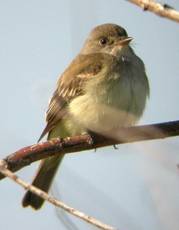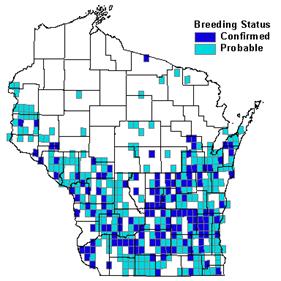Photo by Dave Herr


Status/Protection
- Global Rank: G5 Key to global and state ranks
- State Rank: S4B
- WBCI Priority: SGCN, PIF, State Special Concern
Population Information
Federal BBS information can be obtained at http://www.mbr-pwrc.usgs.gov/bbs/bbs.html by clicking on Trend Estimates and selecting the species in question. All estimates are for 1966-2005.
*Note: There are important deficiencies with these data. These results may be compromised by small sample size, low relative abundance on survey route, imprecise trends, and/or missing data. Caution should be used when evaluating this trend.
- Federal Breeding Bird Survey: significant decline
- Federal Breeding Bird Survey (WI): non-significant increase
- Federal Breeding Bird Survey (BCR 23): non-significant decline
- Federal Breeding Bird Survey (BCR 12): non-significant decline*
- WSO Checklist Project: increasing frequency of reports (1983-2007)
Life History
- Breeding Range: Breeds locally from southern British Columbia east to Atlantic Coast; absent from much of the Great Plains region (Sedgwick 2000).
- Breeding Habitat: Shrub-Carr, Southern Sedge Meadow and Marsh, Grassland-shrub, Forested Ridge and Swale, Dry-Mesic Prairie, and Wet-Mesic Prairie with a shrub component; shrubby lowlands.
- Nest: Cup, average 1-2 m above ground, in shrubs and trees.
- Nesting Dates: Eggs: Early June to early July (Robbins 1991).
- Foraging: Hawks, hover-glean.
- Migrant Status: Neotropical migrant.
- Habitat use during Migration: Similar to breeding habitat.
- Arrival Dates: Early to late May (Robbins 1991).
- Departure Dates: Mid-August to early October (Robbins 1991).
- Winter Range: Southern Mexico, Central America, and northern South America.
- Winter Habitat: Similar to those of breeding range.
Habitat Selection
The Willow Flycatcher is found in a wide variety of woodland edges, boggy forest openings, and roadside shrubs (Sedgwick 2000). In the western portion of its range, it favors dense stands of willow shrubs with moist soil underneath. In Wisconsin it occurs in lowland shrub habitats (especially willow-dominated shrub swamps) and upland habitats with shrubs (Sample and Mossman 1997). Kahl et al. (1985) characterized Willow Flycatcher habitat in Missouri as having dense ground cover (>90%), at least a few woody stems >2.5 cm dbh, an intermediate to high number of woody stems <2.5 cm dbh, and a litter layer of intermediate depth. Willow Flycatchers commonly nest in elderberry, dogwood, honeysuckle, and willow in southern Wisconsin (McCabe 1991). Their nests on average are tidier, located higher in shrubs (Walkinshaw 1966) and are more often placed over water (Sedgwick 2000) compared to nests of the closely-related Alder Flycatcher.
Habitat Availability
The Willow Flycatcher and its closest relative, the Alder Flycatcher, were formerly known together as the Traill's Flycatcher. The Willow Flycatcher generally occupies habitats south of the Alder Flycatcher range (Sedgwick 2000). It is most frequently encountered in the southern half of Wisconsin, being locally common south of La Crosse, Columbia, and Sauk counties, with Horicon marsh and the shores of Lake Wingra being notably good sites (Robbins 1991). It is locally uncommon in the Baraboo Hills region because of limited habitat availability (Mossman and Lange 1982). Several of its preferred habitat types, i.e., shrub-carr and southern sedge meadow, remain common and widespread in the southern region of the state. Other habitats used by this species, including wet-mesic, and dry-mesic prairies, are drastically reduced from their historic levels in Wisconsin (WDNR 2005).
Population Concerns
Population trends are variable across this species’ range, likely due to ecological differences among subspecies (Sogge et al. 2000). Breeding Bird Survey data suggest significant population declines range-wide (Sauer et al. 2005). In the western U.S., the subspecies Empidonax traillii extimus has declined almost to the point of extinction and is listed as a federally endangered species. However, in Wisconsin and other areas of the eastern U.S., the Willow Flycatcher populations appear to be increasing (Sauer et al. 2005). It is considered to be a fairly common summer resident in southern and central Wisconsin (Robbins 1991). During the six-year period (1995-2000) of the Wisconsin Breeding Bird Atlas, observers confirmed breeding in 12% of the surveyed quads (Schultz 2006).
Habitat loss and brood parasitism are two important limiting factors on the breeding grounds (Sedgwick 2000). The eastern subspecies of the Willow Flycatcher, E. t. traillii, suffers an average of approximately 11% brood parasitism by the Brown-headed Cowbird (Sedgwick 2000).
Recommended Management
Conservation measures to protect wetlands in the southern half of the state will ensure breeding habitat for this species. Managers should work to maintain lowland shrub swamps, shrub-carr, and scattered patches of Grassland-shrubs in open grasslands/natural areas for this species (WDNR 2005). Conservation and management strategies for this species should be focused on the following ecological landscapes: Central Lake Michigan Coastal, Central Sand Hills, Central Sand Plains, Northern Lake Michigan Coastal, Southeast Glacial Plains, Southern Lake Michigan Coastal, Southwest Savanna, Western Coulee and Ridges, and Western Prairie (WDNR 2005).
Research Needs
Studies identifying habitat selection and preferences on the winter grounds, and factors limiting winter survival are needed. Migration studies to identify important migration stopovers, determine habitat use, and evaluate migrant condition and stopover time are warranted (Sedgwick 2000). With both the Willow and Alder Flycatchers breeding in Wisconsin, there are many opportunities for comparative ecological and behavioral studies of the two species. Taxonomic changes and confusion with the Alder Flycatcher have reduced the value of data from several older studies. More research on the eastern populations of Willow Flycatcher is needed to compliment the numerous studies involving western populations, including the impact of Brown-headed Cowbird on nesting success.
Information Sources
- Audubon WatchList: www.audubon2.org/webapp/watchlist/viewSpecies.jsp?id=217
- Birds of Forested Landscapes, Cornell Lab of Ornithology: http://birds.cornell.edu/bfl/speciesaccts/sw_wilfly.html (Southwest Willow Flycatcher)
- Patuxent Bird Identification Center: http://www.mbr-pwrc.usgs.gov/id/framlst/i4664id.html
- North American Breeding Bird Survey: http://www.npwrc.usgs.gov
- Temple S.A., J.R. Cary, and R. Rolley. 1997. Wisconsin Birds: A Seasonal and Geographical Guide. Wisconsin Society of Ornithology and Wisconsin Department of Natural Resources, Madison, WI.
- U.S. Fish and Wildlife Service, Southwest Willow Flycatcher website: http://ifw2es.fws.gov/swwf/
- Wisconsin Breeding Bird Atlas: www.uwgb.edu/birds/wbba/
References
- Kahl, R.B., T.S. Baskett, J.A. Ellis, and J.N. Burroughs. 1985. Characteristics of summer habitats of selected nongame birds in Missouri. Missouri Agricultural Experiment Station. Research Bulletin 1056.
- McCabe, R.A. 1991. The little green bird. Ecology of the Willow Flycatcher. Rusty Rock Press, Madison, WI.
- Mossman, M.J., and K.I. Lange. 1982. Breeding birds of the Baraboo Hills, Wisconsin: Their history, distribution and ecology. Wis. Dep. Nat. Resour. and Wis. Soc. Ornithol., Madison.
- Robbins, S.D., Jr. 1991. Wisconsin birdlife: Population and distribution past and present. Madison, WI: Univ. Wisconsin Press.
- Sauer, J.R., J.E. Hines, and J. Fallon. 2005. The North American Breeding Bird Survey, Results and Analysis 1966 - 2005. Version 6.2.2006. USGS Patuxent Wildlife ResearchCenter, Laurel, MD.
- Sedgwick, J.A. 2000. Willow Flycatcher. The Birds of North America, No. 533 (A. Poole and F. Gill, eds.). The Birds of North America, Inc., Philadelphia, PA.
- Schultz, T.R. 2006. Willow Flycatcher. In Atlas of the Breeding Birds of Wisconsin. (N.J. Cutright, B.R. Harriman, and R.W. Howe, eds.) The Wisconsin Society for Ornithology, Inc. 602pp.
- Sogge, M.K., B.E. Kus, S.J. Sferra, and M.J. Whitfield. 2000. Ecology and Conservation of the Willow Flycatcher. Studies in Avian Biology No. 26.
- Walkinshaw, L.H. 1966. Summer biology of Traill’s Flycatcher. Wilson Bull. 78: 31-46.
- Wisconsin Department of Natural Resources (WDNR). 2005. Wisconsin’s Strategy for Wildlife Species of Greatest Conservation Need. Madison, WI.
- Zink, R.M., B.A. Fall. 1981. Breeding distribution, song and habitat of the Alder Flycatcher and Willow Flycatcher in Minnesota. The Loon 53(4): 208-214.
Contact Information
- Compiler: Tom Klubertanz, tklubert@uwc.edu
- Editor: Rick Anderson, rick.Anderson@co.clark.wi.us | Kim Kreitinger, K.Kreitinger@gmail.com
